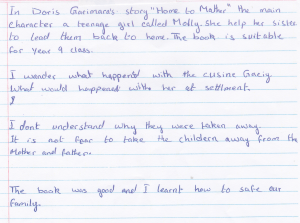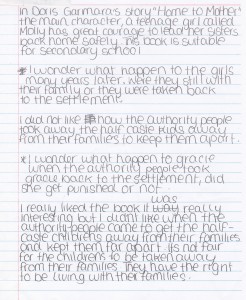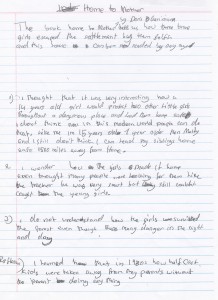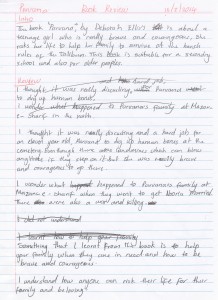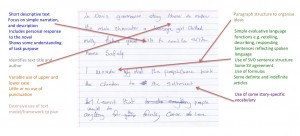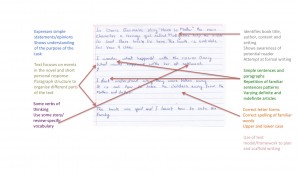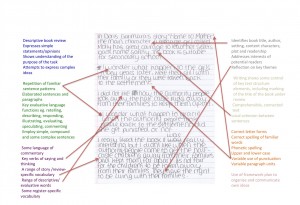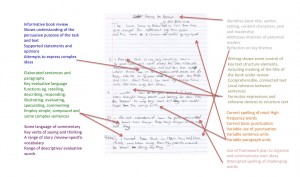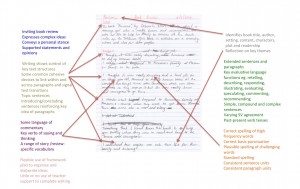19. A book review
Please click on the toggles below to navigate through information on this assessment task and reveal the links for downloading task materials.
Task details |
|
| Name of writing assessment task | A book review |
| EAL curriculum level range | B2, B3, C1, C2, C3 |
| Text orientation | Imaginative |
| Task type | Cued response |
Task specification |
|
| Purpose | To assess students’ ability to write a convincing evaluative response to a literary text. |
| Description | Students write a review of a shared text that the class have read and analysed for main events, characters, setting, themes, etc. |
| Assumed knowledge and description |
|
Learning/teaching context |
|
| Language centre/mainstream class | EAL support |
| Subject/key curriculum objectives, outcomes | English, understanding literature |
| Topic/teaching unit | Literature, theme-based unit |
| Assessment conditions |
|
| Notes |
|
Task implementation |
|
| STAGE | ACTION STEPS |
| Pre-assessment activity |
|
| Assessment activity |
|
| Post-assessment activity |
|
TEAL Writing Task 19 – unmarked criteria sheet [PDF]
TEAL Writing Task 19 – unmarked criteria sheet [Word]
An explanation of the purpose, nature and use of criteria sheets is available at 4. Using the assessment criteria.
General commentary
Nature and purpose of the task
This task is related to TEAL Oral Task 19: A book or film review, and TEAL Written Task 20: A film review. A review of a book is a complex text that has descriptive, narrative and evaluative elements. It is a common classroom task for students in schools, and a text type that is common in the media in Australia. It is also a way of assessing how EAL learners have responded to class texts they have read. This makes it is a useful writing task that provides insight into students’ skills in writing a relatively complex text type, but also gives insights into their reading and interpretation of a literary text. For students in the relatively early stages of learning EAL, the text requires some scaffolding to assist them with the complexity of the task. In this case, the 3D review framework for a book review was provided. This framework tends to put an emphasis on the students reporting their responses to the text, rather than writing a review that persuades others to read or not read the book. The 3D framework provides a strong structure for their reviews (Describe, Disclose and Decide), but also provides prompts and language structures to introduce sentences in each section. The students have utilised this to provide a common structure for all the sample texts, and have reproduced many of the prompt sentence beginnings to assist them in writing their reviews.
Commentary
These samples were produced by students in a Year 9 mainstream class in a secondary school. Four of the samples refer to Home to Mother by Doris Pilkington Garimara (University of Queensland Press, 2006) and one relates to The Breadwinner also known as Parvana) by Deborah Ellis (Groundwood Books, 2000). Both books are written for teenage audiences. Home to Mother describes the experiences of three girls taken by authorities from their aboriginal mother, who decide to leave the institution they are taken to, and their long journey home through the bush. The Breadwinner is the story of girl and her family living under Taliban rule in Afghanistan.
The texts produced by these C1, C2 and C3 EAL students show that with the scaffolding provided, the students are able to write texts that present their responses to the novels they have read in class. The reviews range from quite short and relatively simple, to longer texts that provide more detail and complexity. All include noticeable grammatical and writing errors, but are still quite comprehensible. The clarity and neatness of the texts varies, and some of the crossing out and revisions are quite revealing in showing how the students approached the task. The students’ control of English varies between the samples, and the range of texts also reveals how the number of errors made by EAL learners in their writing can increase as they attempt to communicate more complex meanings. It is also interesting to think about the neatness and clarity of presentation of a written text separately from the quality of the language used, and not be misled into thinking neatly presented texts are necessarily stronger. The commonality of the use of the introductory sentences in the samples, including attempts at a subordinate clause to identify the main character, suggests this was a model presented in the classroom.
Sample 1
Year level: 9
Home language: Dari
Commentary
This text is basic, and short, and closely follows the structure of the framework presented to support students in completion of the task. The briefly expressed information shows that the student understands the different parts of the story, but the student also reports not understanding why Molly was taken away from her family and taken to the settlement.
The writing is clear and comprehensible, and follows much of the structure expected in such a text, directed by the planning framework provided to the students. Each of the three paragraphs comprise a single sentence, which is grammatically acceptable, even though appropriate punctuation is not used to mark the sentence boundaries. The first paragraph is a quite a complex sentence with correct subordination, but without appropriate punctuation, not only of the subordinate clause, but also of a final full stop. It is possible the student has relied heavily on a model in class, but missed the punctuation. The second paragraph sentence has a problem successfully using the prompt starter, which changes the grammar in the sentence from a question into a statement. However, the student doesn’t seem to understand this and commences the sentence with I wonder why did… The expression ‘came took’ may be a case of a missing and – came and took, or an attempt at a more complex verb structure came to take. The final sentence is more grammatically correct (despite missing final full stop) and uses a modal would for a general statement of people’s motivations, which is a more sophisticated meaning and structure. The omission of most punctuation, and the appearance of some letters s in safely and c in called suggest the student is still adjusting to writing in a way that clearly demarcates upper and lower case letters.
The brevity of the text makes it relatively easy to identify errors made by the student in writing the text, but the heavy scaffolding and brevity also makes it harder to infer the students’ general writing skills for this sample. The student may be using some expressions from classroom discussions in a formulaic manner, or alternatively, may be deliberately confining herself or himself to writing a brief and highly controlled text in order to limit the extent of the mistakes she or he believe they may make.
The marked criteria sheet shows that the student meets most criteria at Level 1.
The student’s language use in this task is consistent with the descriptions of students at Level C1, Victorian Curriculum F-10 EAL.
Using this assessment to further learning
- Punctuation of sentences and clauses:
Ask the student to read the text aloud. Point out where he or she pauses, and explain how these represent sentence boundaries.
Explain, and if necessary model, the use of a capital letter and full stop to mark the beginning and end of sentences in a written text.
Ask the student to review the text and check that the sentences begin with capital letters and end with full stops.
- Statements and questions
Ask the student to review the table below, especially the first two examples. You may need to point out the differences in structure and punctuation between statements and questions.
Ask the student to write the matching question or statement where only one is given:
| Statement | Question |
| Molly takes great risks to help her sisters. | Does Molly take great risks to help her sisters? |
| I wonder why people came to take the children away. | Why did people come to take the children away? |
| Did the children get home safely? | |
| Did Doris Garimara write Home to mother? | |
| The authorities took the girls to the settlement. | |
| I would do anything to save my family. |
- Upper and lower case letters
Ask the student to look at this information about when to use upper and lower case letters
| Use upper case (capital) letters | Use lower case (‘small’) letters |
|
• the beginning of a sentence • the first letter of a person’s name • the first letter of the name of place, like a city or town • an acronym, like PIN (for personal identification number, which you have for a credit or bank account card.) |
all other letters |
| Hint for writing capital and lower case letters: Be careful with letters that look the same in both lower case and upper case, like C, K, P, S. Make sure you keep lower case letters small, so they are not mistaken for upper case, especially when they look the same! | |
Now ask the student to check and revise the use of upper and lower case letters in the text.
Sample 2
Year 9
Home language: Dari
Commentary
This review reflects the scaffolding given to students to help them complete the task. This text is longer than Sample 1, and provides more information. There is greater control over the mechanics required for production of the text. There is an inappropriate gap of two lines in the second paragraph, and some noticeable spelling errors, such as cusine for cousin, safe for save, and fear for fair. However, the grammar is controlled, despite some errors, including the missing main verb in the opening sentence, subject-verb agreement (She help), some errors in using articles (the cusine Graciy, at settlement) and unnecessary prepositions back to home.
The text includes an evaluative sentence in the final paragraph, as well as the more descriptive information in the earlier paragraphs.
The writing is clear, and is generally correctly punctuated, despite missing apostrophe in don’t.
The marked criteria sheet shows that the student meets most criteria at Level 2, and some at Level 1.
The student’s language use in this task is consistent with the descriptions of students at Level C2, Victorian Curriculum F-10 EAL.
Using this assessment to further learning
- Spelling
Ask the student to look at this list of words from the text.
|
fair save children Gracie suitable cousin settlement |
Ask the student to check how he or she spelt these words in the text, and to correct any that were spelt incorrectly. Ask the student what strategies they used to find the correct spelling.
- Verbs
Ask the student to correct the verbs in the following sentences, by writing the missing word, using one word from the list of words provided in the box
| is helped have led |
The main character ______ a teenage girl.
Molly _________________ them home.
What would ____________________ have happened at the settlement.
She ____________________ her sister.
- Formatting paragraphs
Remind the student that a paragraph not only presents a single main idea, but that all the relevant sentences need to be written together as a group. Ask the student to draw lines in pencil around the three paragraphs in the text. Check how this is done.
Now ask the student to re-write the text, with the sentences of each paragraph grouped so they follow each other without breaks or gaps.
Sample 3
Year: 9
Home Language: Dari
Commentary
This text is longer and provides more detail than Samples 1 and 2. It is clearly and neatly presented, but there are errors in the way it is structured and the language that is used. The second and third paragraphs cover more points and give more details than Samples 1 and 2, and the final paragraph provides greater explanation and reasons for the student’s opinion of the text. However, there are some significant issues of text structure: the spacing between sentences in paragraph 2, and what seems to be the use of two asterisks to signal the two points being made in paragraph 2.
There are some problems of plural forms of words (childrens) and past tense forms of verbs (what happen). The handwriting is clear and neat, and the student seems to be using circumlocution authority people, to make meanings clear. The student uses more subject appropriate vocabulary, such as half-caste, authority, and settlement than the earlier samples.
The marked criteria sheet shows that the student meets criteria spread across Levels 2 and 3.
The student’s language use in this task is consistent with the descriptions of students at Level C2, Victorian Curriculum F-10 EAL.
Using this assessment to further learning
Formatting paragraphs
- Remind the student that a paragraph not only presents a single main idea, but that all the relevant sentences need to be written together as a group. Ask the student to draw lines in pencil around the three paragraphs in the text. Check how this is done.
- Using a topic sentence to open a paragraph:
- Ask the student to add the following topic sentence to the paragraph where it fits best:
- The book left me with some questions, and there were some things I liked and didn’t like.
- Now ask the student to re-write the text, with each paragraph grouped together, using the topic sentence added above.
Punctuation check list
Ask the student to look at the following table of key punctuation elements and how they are used.
Ask the student to mark the final column to indicate if this mark is used correctly in the text or not.
| Punctuation mark | Use |
In my text √ or X
|
| Capital letters A, B, C |
Beginning of a new sentence, Names of people and places Days of the week and months |
|
| Full stops . | End of sentence or abbreviations | |
| Inverted commas “…..” |
Around the name of a book or film Around words actually spoken (direct speech) |
|
| Question marks ? | At the end of sentence which is a question. Replaces the fill stop in a question. | |
| Apostrophe ‘ |
To mark where a letter or letters are left out when some words are shortened, for example, can’t, isn’t To show when some owns something, for example, Mary’s book |
Asking questions about past events
(a) Look at these different kinds of questions about events in the past, or in a story:
|
Did they get punished? Were they afraid? Were they returned? Did they get caught? |
Review the text to see where questions like this are used. Check they are formed correctly.
(b) Ways of speculating about past events.
|
I wonder if they were punished? I wonder if they were afraid? I wonder whether they were returned? I wonder if they were caught? |
Review the text to see where questions like this are used. Check they are formed correctly.
Sample 4
Year: 9
Home language: Swahili
Commentary
This text is more elaborate in meaning and uses more original expression than Samples 1, 2, and 3, despite having notable errors of structure. It draws much less explicitly on the prompt given to the students, and attempts to express a wide range of meanings. However, in being a more original text, it also includes more noticeable errors of linguistic structure. These include a problem of layout, with points being numbered rather than marked by paragraphs, and then a subheading Reflection. There are many noticeable grammatical errors such as the sentence structure in the point numbered 1; Like me I’m 15 years old, which is inappropriately conversational for this written text, and excessively long. There is an incorrectly structured sentence in point number 2. There are a range of vocabulary errors including themselves, 14 years old girl, thought for though, and they parents for their parents.
The formatting is not particularly tidy, but the paragraphs are consistently spaced out, except for the first paragraph. The text shows some evidence of self-correction. Some letters that should be lower case are upper case, ‘t’ sometimes looks like a capital. There is a missing apostrophe in couldn’t. While most high frequency words are spelt correctly, a number are misspelt. The handwriting is mostly legible, but the formation of some letters such as ‘o’ can make some words difficult to read. .
The marked criteria sheet shows that the student meets most criteria at level 3 with some at level 2.
The student’s language use in this task is consistent with the descriptions of students at Level C2, Victorian Curriculum F-10 EAL.
Using this assessment to further learning
- (a) Using and arranging paragraphs
Remind the student that paragraph not only presents a single main idea, all the relevant sentences need to be written together as a group. Ask the student to draw lines in pencil around the three paragraphs in the text. Check how this is done.
(b) Using subheadings
Explain how subheadings can be used in academic writing to help signal the structure of the text. Show the student some examples.
Ask the student to identify three appropriate subheadings for the text, from the list below: (There are more possible headings than are needed)
|
My reflection
Details and focus of the book
Main characters
Other people’s reactions to the book
My responses to the story
|
Ask the student to rewrite the text using the selected subheadings, and properly formed paragraphs under each one.
Emphasise the need for a tidy final product.
- Spelling
Ask the student to review this list of words used in the review, and check whether they are spelt correctly in the student’s text:
| interesting | themselves | safely |
| though | survived | parents |
| their | half caste | than |
| siblings | couldn’t | fourteen year old |
Ask the student to check for any other spelling errors in the text.
- Managing sentence structures
(a) Ask the student to read aloud the paragraph numbered 1. Point out when she pauses, and ask if the number of sentences equals the number of pauses made in reading the text, discuss the problems of excessively long sentences, such as it is much harder to ensure the grammar of a long sentence is correct.
(b) Ask the student to match the sentences in the table below with the sentences in the text. Draw an arrow from the sentence on the left to the part of the paragraph the expresses the same idea.
| I thought it was very interesting that a 14 year old girl would protect two other little girls. | I thought that it was very interesting how a 14 year old girl would protect two other little girls throughout a dangerous place and lead them home safely I don’t think now in this modern world people can do that. Like me I’m 15 years old one year older than Molly and I still don’t think I can lead my siblings home safely 1500 miles from here. |
| I’m a year older than Molly, but I don’t think I could lead my siblings safely home over 1500 miles. | |
| They were in dangerous place and had to make a long trip. | |
| I think that an unusual thing in this modern world. |
Now ask the student to sequence the four sentences on the left to make a paragraph which expresses the same ideas as in the original paragraph in the text.
(c) Ask the student to rewrite paragraph 2, using shorter sentences.
Sample 5
Year 9
Home language: Dari
Commentary
This text is wider in scope, more expressive, and provides a stronger sense of the student’s voice than the other samples. This text provides more details about events in the story, and more reasons to support opinions that are expressed. While the formatting of the text is more conventional for school writing activity, the use of titles and subheadings, is not complete and systematic, and the concluding section would benefit from a subheading. There are some grammatical errors in sentence structure (including the first sentence, and the sentence at the end of Paragraph 3, There were a war and killing.). There are some problems with verbs, there was landmines, some errors in vocabulary choice, such as overuse of brave and courageous, and an incorrect plural of peoples.
The student has self-corrected during the writing, which reveals the student’s initial ideas and how these have been expanded upon after he or she has reread the text, and shows how his or her thinking develops.
The marked criteria sheet shows that the student meets most criteria at level 3 and some at level 4.
The student’s language use in this task is consistent with the descriptions of students at Level C3, Victorian Curriculum F-10 EAL.
Using this assessment to further learning
- Using subheadings
Compliment the student on the use of subheadings, but point out that it seems incomplete.
Discuss the following options for a subheading for the final two paragraphs. Consider the advantages and disadvantages of each, and whether there would be any other alternatives:
Conclusion Reflection and reaction
Ask the student to choose a suitable subheading, and insert it into the text.
- Fitting ideas into sentences
Ask the student to review this paragraph:
- Ask the student to make a short line in pencil, to separate the different ideas or information provided in the paragraph.
- Ask the student to experiment on a rough piece of paper to try some different ways of joining these ideas, so that no more than two ideas are given in any one sentence.
- Ask the student which of the options are preferable, and to use this when student rewrites the text.
- Spot the mistake!
The student has expressed her ideas clearly, but there are some one-off grammar and spelling errors that undermine the credibility and authority of the text in the eye of a reader who is expecting formal academic writing. Asking the student to revise the text, looking for such errors (which may be mistakes caused by the student focusing on expressing ideas), or indicative other gaps in language knowledge. Asking the student to review work for such errors from time to time helps the student to become aware of such problems, and provides a foundation for any further teaching that might be needed to address these.
Ask the student what is wrong with these words or expressions from the text:
|
by Deborah Ellis’s at the harsh rules of the Taliban older peoples
discusting there was landmines There were also a war and killing
for their family and beloving |
Ask the student to correct these in the text, or when the text is next revised.

